The field of artificial intelligence (AI) research was founded at Dartmouth College during the summer of 1956. Fast-forward more than 60 years to the year 2018 and we are seeing expansive growth in the development of AI, referred to in the business as the “Summer of AI."
AI by no means languished for all those years in between, but it was only recently that computational speed and memory caught up to the possibilities that AI could provide in today’s data intensive world. And, uncharacteristically, the usually lagging pharma industry is stepping up. As a multitude of companies, other industries, and even country governments explore the potential of AI technologies, the pharma industry is also embracing the opportunities that artificial intelligence and machine learning have to offer across all spectrums of business operations.
A 2018 TechEmergence study tapping healthcare industry executives currently using AI revealed that more 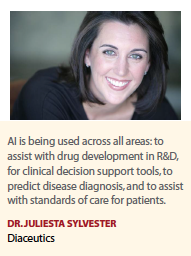 than 50% anticipate broad scale AI adoption by 2025 and nearly half expect that initial AI applications will target chronic conditions.
than 50% anticipate broad scale AI adoption by 2025 and nearly half expect that initial AI applications will target chronic conditions.
For AI to be successful in the life-sciences sector, the industry will need sound data science with high-quality data and advanced computing power, a sharp focus on algorithms that address specific care areas, and top-down strategic deployment.
Experts say in the life sciences, AI will need to be integrated into the manufacturing workflows, software applications, and hardware devices that are already in use today. And, it will need to be methodically developed and validated according to research and industry regulations.
“The cost of data computing and storage has effectively gone to zero, which means the industry has the ability to apply massive amounts of computational data to train models, which results in the ability to build massively deep neural network type models," says Guido Lanza, CEO and co-founder of Numerate, a data-driven drug design company that is applying AI to drug discovery. “And, now there is an explosion of AI into different spaces — transportation, healthcare, silicone chip design, and so on," he says. “The healthcare industry and the pharmaceutical industry are experiencing a knock-on effect as are many other industries; there isn’t an industry that’s not dealing with AI right now."
Our experts agree that AI has the potential to impact all areas across the life-sciences spectrum — from R&D, to commercial, to patient outcomes — and the applications have far-reaching implications.
Beyond developing a “data-first" culture, someone in the company needs to define and own the AI journey. In many organizations, IT approaches AI from the technology perspective, R&D from the data and analytics perspective, and commercial from an innovation and engagement perspective. Senior leadership support varies and no one is harmonizing the journey to drive maximum value.
AI: R&D/Clinical Opportunities
According to Marco Anelli, M.D., head of pharmacovigilance and the medical affairs advisory services 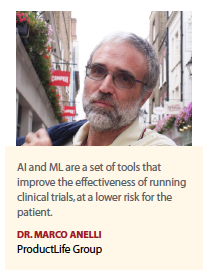 practice at ProductLife Group, the driver for AI in the life sciences is cost-effectiveness, especially since there are areas in the operation of a pharmaceutical company that are very expensive and could benefit from a reduction in cost, or an increase in efficiency or effectiveness originated by machine technology.
practice at ProductLife Group, the driver for AI in the life sciences is cost-effectiveness, especially since there are areas in the operation of a pharmaceutical company that are very expensive and could benefit from a reduction in cost, or an increase in efficiency or effectiveness originated by machine technology.
“Pharma is using AI and machine learning in R&D, for example, for gene analysis; with a high throughput string, companies can end up with terabytes of data, and there’s no way to sift through this data unless they use machine learning data science or artificial intelligence technology," Dr. Anelli says. “I view AI as a set of tools that improves the effectiveness of running clinical trials and all other activities needed to support a drug during its life cycle. And by effectiveness, I mean also lower risks for patients."
“In R&D, AI is being actively explored to build out the laboratory of the future," says Christopher Waller, Ph.D., VP, chief scientist, EPAM, a software engineering and IT consulting company. “The vision of a laboratory full of smart devices, instruments, and equipment all streaming data into the cloud with real-time AI acting as an intelligent virtual partner that either suggests or performs the next experiment is compelling — and a little scary."
In a clinical setting, the real-time monitoring of biomarkers related to treatment progression enables an AI device to adjust treatment frequency or dosage to optimize outcomes. Developing new compounds through clinical trials can take more than a decade and cost billions of dollars. AI is being used to make this process faster and more efficient, Dr. Waller adds.
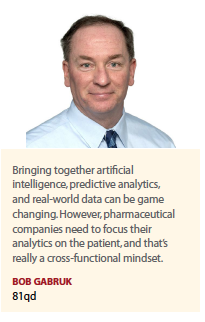 Within pharmacovigilance, companies are using natural language processing and AI to automate drug safety analysis. Additionally, AI will help pharmaceutical companies improve their patient services programs, including enabling virtual nursing assistants.
Within pharmacovigilance, companies are using natural language processing and AI to automate drug safety analysis. Additionally, AI will help pharmaceutical companies improve their patient services programs, including enabling virtual nursing assistants.
Dr. Anelli says pharma companies — especially large companies — are best able to use the cutting-edge applications of artificial intelligence and machine learning. “Companies such as GlaxoSmithKline, Novartis, and Pfizer — the biggest players — can afford an internal data science group, which will deal with AI and machine learning in the fields of drug technology and pharmacology," he says.
He expects AI use and adoption to take place in clinical or preclinical stages as well with a trend toward substitute animal experiments with simulated animals. “Companies can predict with a very good degree of certainty using AI if, for example, a drug may be a carcinogen or a mutagen," Dr. Anelli says. “This saves time, money, and the lives of a lot mice."
“The industry is at an interesting tipping point as there is a strong desire to become more digital," Dr. Waller says. “This represents a paradigm shift from the legacy ‘experiment-first’ culture where data was collected to disprove — or more often prove — a hypothesis and generally discarded or at best stored and never used again to a ‘data first’ culture where data scientists play a key role in the transformation. AI will naturally start to replace natural intelligence resources as the industry learns the value of the data and trusts the intelligence — natural or artificial — that is driving change."
Dr. Waller sums up the current status of AI within the industry: “AI has tremendous potential, but alone it’s not the answer; this will be a journey."
AI can also be used for patient finding and for improved diagnosis, especially for rare diseases, our experts say.
“Bringing together AI with predictive analytics and real-world data (RWD) is where AI can be game changing," says Bob Gabruk, managing director, 81qd. “But to be game changing, pharmaceutical companies and other healthcare entities need to be more patient-focused with their analytics, which requires a cross-functional mindset spanning R&D and commercial."
 Some say AI can be very impactful in the rare disease space. Patient finding in rare disease is difficult and is all about identifying patients who can be lost in the healthcare system because the disease is difficult to diagnose. Even for some diseases with incidence rates much higher than a rare disease, patients often go undiagnosed and therefore untreated. Diagnosis can take from eight to 14 years in some cases, however, with the use of AI, predictive analytics, and RWD, patients who haven’t been diagnosed can be identified as being highly likely to have the disease. Armed with this knowledge, physicians can better manage and improve diagnosis rates.
Some say AI can be very impactful in the rare disease space. Patient finding in rare disease is difficult and is all about identifying patients who can be lost in the healthcare system because the disease is difficult to diagnose. Even for some diseases with incidence rates much higher than a rare disease, patients often go undiagnosed and therefore untreated. Diagnosis can take from eight to 14 years in some cases, however, with the use of AI, predictive analytics, and RWD, patients who haven’t been diagnosed can be identified as being highly likely to have the disease. Armed with this knowledge, physicians can better manage and improve diagnosis rates.
“And the outputs to a patient-finding solution can be leveraged cross-functionally across those teams that are involved in developing new products and then commercializing them," Mr. Gabruk says.
Another important application of AI, predictive analytics and RWD is to identify the true clinical influencers — those individuals who impact the care of patients far beyond their own practice through their clinical networks. This helps drive the diffusion of innovation throughout the healthcare system. These insights can be leveraged across a pharmaceutical organization to execute influence-based marketing initiatives, optimize medical science liaison teams, enhance salesforce efficiency, and improve managed care pull-through programs.
“AI makes it a really exciting time to be in the rare disease space right now, but it’s also a scary time because there are large amounts of data that need to be harnessed and secured," says Annemarie Crivelli, director of digital at Cambridge BioMarketing.
AI can potentially facilitate processes such as connecting data, searching medical records in EHR systems, and accessing genomic testing to aid in diagnosis, which can lead to faster paths to treatment plans and options. AI can also assess what’s been done before, what’s worked, what hasn’t, all of which allows physicians to adjust and learn to make better recommendations later.
Michael Sierra, Ph.D., VP, LEO Science & Tech Hub, foresees a future where AI and big data could play a key role in enabling precision medicine by tapping into information available in electronic medical records, biomarkers, environment etc., and this could help with preventive care, for example predicting a flare up in psoriasis.
“There are opportunities in all sectors, but particularly in electronic medical records," Dr. Sierra says.
“However, the U.S. system is really behind Europe in terms of the ability to use EMR."
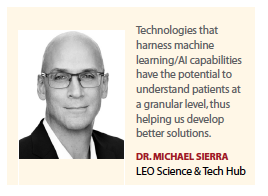 “Instead of treating the symptoms, physicians can start preventing disease," he says. “But to get to that point, because there’s too much data for a simple algorithm to be able to find the relationships, AI and cognitive computer learning are needed to identify the relationships and identify opportunities."
“Instead of treating the symptoms, physicians can start preventing disease," he says. “But to get to that point, because there’s too much data for a simple algorithm to be able to find the relationships, AI and cognitive computer learning are needed to identify the relationships and identify opportunities."
Dr. Sierra predicts that in the next five years or so, these are the types of advances that are expected. “The use of AI is starting to push the understanding of what is actually happening with patients, for example, responders versus nonresponders. When we can get to the point of understanding sub-types of patients, this will lead to much better outcomes and positive impacts on patients’ lives."
While AI is being used across all areas to assist with drug development in R&D, for clinical decision support tools, to predict disease diagnosis, and assist with standards of care for patients, at Diaceutics, the company is focused on optimizing strategies for companion diagnostic tests.
“Our approach is primarily patient-centric, although we do significant analysis on data we receive from laboratories, physicians, and payers; our objective is to benefit patients and ensure they get the right test and the right treatment at the right time," says Juliesta Sylvester, Ph.D., managing director, global data and analytics at test commercialization firm Diaceutics. “From a practical standpoint, we are using AI to standardize data coming in from various sources and build robust profiles to identify risks and opportunities throughout the patient’s journey."
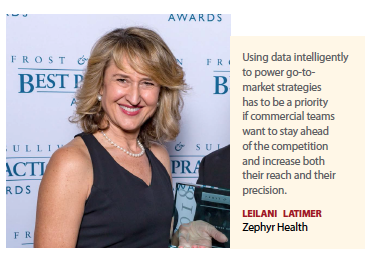 Diaceutics uses AI because of its ability to scale large and complex data sets with millions of patients and tens of millions of test results over different periods of time. “Being able to separate out various patient profiles lets us know, for example, that a patient with breast cancer who is being tested for a particular set of biomarkers may expect to get a second series of tests at some point in the future," Dr. Sylvester says. “There may be evidence to suggest that parallel testing is more beneficial than sequential testing, or that an alternative biomarker set should be tested based on that patient’s history. Both of these predictions can help a patient gain earlier access to a useful therapy; sooner is better than later."
Diaceutics uses AI because of its ability to scale large and complex data sets with millions of patients and tens of millions of test results over different periods of time. “Being able to separate out various patient profiles lets us know, for example, that a patient with breast cancer who is being tested for a particular set of biomarkers may expect to get a second series of tests at some point in the future," Dr. Sylvester says. “There may be evidence to suggest that parallel testing is more beneficial than sequential testing, or that an alternative biomarker set should be tested based on that patient’s history. Both of these predictions can help a patient gain earlier access to a useful therapy; sooner is better than later."
Profiling patients is only the first step, Dr. Sylvester says. Identifying the most influential levers to affect change is the second; and effectively pulling those levers is the third. “It is important to look at all of the players — from the physician to the insurance company to the laboratory to the professional bodies that set the guidelines — to see how to support patient access to molecular testing and, therefore, to molecularly targeted therapies," she says. “If we can improve access to high-quality molecular testing, we can improve diagnosis and ultimately save lives in some cases."
AI: Commercial Opportunities
Right now there are exciting and tangible opportunities for commercial teams (brand leaders, marketers, sales) in pharma to leverage machine learning and AI to improve everything in their go-to-market strategies, from product launch to product value proposition, to customer engagement, according to Leilani Latimer, VP global growth, Zephyr Health.
“As pharma evolves from being product-centric to being market- and patient-centric, it needs to map a more targeted sales strategy for relevant stakeholders to improve sales while delivering value to end patients," she says. “To do this, and to ensure commercial viability, companies must be able to aggregate, process, and interpret high volumes of diverse, unstructured, and difficult-to-integrate data sources — something that is no longer possible with manual systems.
“With machine learning solutions, we can access and activate large amounts of data, constantly improving our ability to target the right customers, via the right channels," Ms. Latimer continues. “Using data intelligently to power go-to-market strategies has to be a priority if commercial teams want to stay ahead of the competition and increase both their reach and their precision."
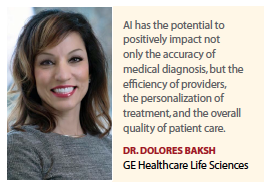 Interoperability remains one of the industry’s biggest challenges to adopting AI, Ms. Latimer says. There are numerous solutions for different needs, but often there is no single person or group tasked with looking across the commercial enterprise to determine how to bring these unique and valuable offerings together. For life-sciences companies to successfully adopt AI solutions, they need a supporting change management framework that incorporates strategy, culture, people, and process along with the technology itself, she adds.
Interoperability remains one of the industry’s biggest challenges to adopting AI, Ms. Latimer says. There are numerous solutions for different needs, but often there is no single person or group tasked with looking across the commercial enterprise to determine how to bring these unique and valuable offerings together. For life-sciences companies to successfully adopt AI solutions, they need a supporting change management framework that incorporates strategy, culture, people, and process along with the technology itself, she adds.
At the patient level, Cambridge BioMarketing is using machine learning to automate communication strategies by identifying triggers on a patient’s journey or an HCP’s journey within the created properties and then automating and learning what’s working and what isn’t. Ms. Crivelli says the company is also developing chatbots and personalized assistants, which also rely on AI for implementation.
“Many patients have to take multiple treatments, multiple prescriptions, every day, if not sometimes multiple times a day, and so an application that can help remind them as well as provide better connections with their physicians is very valuable," she says. “AI can then learn over time what patients are doing, when they are doing what, at what time they are taking their medications — learning and understanding this routine pattern can help patients stay on their treatment plans."
“One of the biggest challenges with the healthcare industry is the protection of personal data," Dr. Sierra says. “Clearly, there have to be protections, but we need to figure out how to get anonymized data that still connect to all of the other parts to be able to power an AI approach."
Companies are trying to figure out the best way from both a regulatory point of view and an ethical point of view on how to obtain data and protect privacy at the same time.
AI: Patient Outcomes Opportunities
In terms of patient outcomes, AI has broad applicability ranging from dose management to environmental control in the hospital of the future.
Timon LeDain, director of emerging technologies at Macadamian, a user experience design and software development firm, believes AI is transforming the delivery of healthcare with an emphasis on improving patient outcomes. “AI is extending and improving patient diagnosis by combining computer vision with traditional medical imaging techniques such as MRI and tomography scans to provide specialists with clinical decision support," he says. “AI is also opening up new diagnostic pathways and approaches, such as in leveraging natural speech samples from a patient to diagnose depression, dementia, aphasia, and other cognitive conditions."
He adds that even homecare is quickly evolving to integrate voice-based virtual assistants where advances in AI will enable more sophisticated, personalized, and empathetic virtual health coaches that leverage data from wearables and ambient sensors to identify and respond to adverse health events.
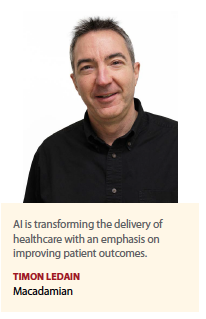 GE Healthcare is partnering with academic institutions and industry leaders to develop and integrate AI, deep learning, and analytics into every part of patient care. For example, GE and Roche entered into a partnership to develop a digital diagnostics platform to improve oncology and critical care treatment.
GE Healthcare is partnering with academic institutions and industry leaders to develop and integrate AI, deep learning, and analytics into every part of patient care. For example, GE and Roche entered into a partnership to develop a digital diagnostics platform to improve oncology and critical care treatment.
“The partnership is applying techniques in machine learning to a patient’s complete healthcare picture to help determine the best course of treatment," says Dolores Baksh, Ph.D., innovation leader for cell therapy technologies at GE Healthcare Life Sciences. “AI has the potential to positively impact not only the accuracy of medical diagnosis, but also the efficiency of providers, the personalization of treatment, and the quality of patient care."
GE Healthcare also is making efforts in combining data analysis with predictive analytics, machine learning, and artificial intelligence to help reduce risks in biomanufacturing and improve productivity outcomes.
“Nearly all our equipment across the life-sciences portfolio comes with software solutions that are digitally connected to central dashboards for monitoring purposes," Dr. Baksh says. “With more data collected, we can make more informed manufacturing decisions that can positively impact the quality of the end therapeutic product. The hope is that being able to correlate data to patient outcomes can help the industry drive toward long-lasting therapeutic efficacy for improved patient outcomes."(PV)
~~~~~~~~~~~~~~~~~~~~~~~~~
Best Practices: AI Adoption
 Andrew Breza
Andrew Breza
Director of Data Insights and Analytics, Bulletin Intelligence
It’s the wrong approach to ask where are the best opportunities for AI because piecemeal adoption by a few departments will not work. It’s easy to see the amazing advancements in AI and develop an all-encompassing sense of FOMO.
It’s important for professionals involved in all stages of the pharmaceutical pipeline — from life sciences to marketing — to prioritize human intelligence and good judgment as they transition into the next era of computational sciences.
New technologies must be thoughtfully integrated into an organization’s corporate culture. C-suite executives need to understand their companies well enough to determine when to turn to AI instead of traditional tools for organizational performance. Improvements to technology will inevitably come to all stages of the pipeline, and organizations that know how to manage this change in a cohesive and systemic way will always outperform individual departments chasing shiny toys.
 Annemarie Crivelli
Annemarie Crivelli
Director of Digital, Cambridge BioMarketing
Data scientists are one of the fastest-growing career paths right now, and as we know with machine learning and AI, data management is the most important aspect. I anticipate we will see data management become more infused into the business models of life-sciences and pharma companies of the future. It’s going to be very important to educate across all of the key disciplines, whether it’s marketing or R&D, to know what’s possible and how to be innovative with AI and machine learning.
One of the biggest challenges for any organization is one of infrastructure. Can a company handle the scalability, the architecture, the performance needs of machine learning or an AI application across the organization?
The integration of systems is really important, as is the governance around how companies handle this, which leads into the data management aspect and what is being done with the data.
Lastly, the security of the data and how companies handle it in the short term is really important. There are many organizations that are using AI, machine learning technology, and accessing large amounts of data online. Accessing and partnering with organizations like IBM, Accenture, Deloitte, and Salesforce that have AI health clouds have the infrastructures, systems, data management processes, and security that will help life-sciences companies evolve faster than relying on in-house processes.
 Bryan Hill
Bryan Hill
Chief Technology Officer, Life Sciences, Cognizant
Besides cost, some of the biggest challenges with AI implementations today are expectations, talent, and data.
AI is not a black box that you plug in, feed data, and get answers to complex problems without a clear idea of the problem to be solved, the data requirements, and the talent to communicate with and train the machine.
Whether drug discovery or bot-driven customer service, broader adoption requires leadership to prioritize areas of opportunity for AI and to focus on framing the business problem for each opportunity so that there is clarity in the question AI is expected to answer.
An important next step in preparing for AI is driving an open data culture. Far too often, data is in silos by business function and kept in an ever-expanding warehouse of hidden treasures. Well-organized, well-defined, hi-fidelity data that are accessible across functional areas of the business and partners will become the fuel for successful AI. Data.gov and Kaggle.com embody this approach and serve as a ready-state “datavation" platform for machine learning and data-intensive AI solutions.
Lastly, to really make things hum, it comes down to people. While we may look for the unicorns that possess the informatics, functional analytics, and AI/ML skills, the reality is that cross-functional teams that bring all these talents together effectively are the more likely organizational approach. Depending upon the application of AI, other roles we see in the AI dream team of the future include behavioral scientists, futurists, and experience strategists.
 Dean Sellis
Dean Sellis
Chief Technology Officer, Antidote.me
AI is not a panacea, and not all applications will have the — potentially hyped — impact on life sciences as we’ve seen with chatbots and customer service. Still, the industry should prepare; there are so many ways AI can be used that there will be many paths to adoption and success.
The biggest challenge will be building the expertise to effectively leverage AI to solve industry problems. The industry will have an ongoing struggle to build teams with the right mix of education, training, and experience to make a difference. Four steps organizations can take to get there are: instill a plan and support for the AI technologists to stay current on the latest techniques as it’s a rapidly evolving space; create programs for frequent and continuous knowledge-sharing between technologists and clinical researchers; ensure departments have the communications channels and tools necessary for data analysis at scale, e.g. the data share between clinical operations department and R&D; and support university specialization programs through both funding and real-world data sharing to help cultivate the talent pipeline of tomorrow.
 AJ Triano
AJ Triano
Senior VP, Engagement Strategy, GSW, a Syneos Health company
First, the industry must work harder to co-create and socialize all its learnings, techniques, and codes with regard to AI, which means sharing data with each other in real time. Big tech has found many ways to do this through forums such as the IEEE, open software initiatives, GitHub, and the like.
Second, we need proactive participation in standard settings, including how we validate our work to ensure the AI engines we create are delivering results that actually improve patients’ lives.
Third, we must involve all stakeholders in AI initiatives, and not just those most pertinent to making money.
Syneos Health recently surveyed about 1,000 patients and caregivers to better understand their expectations for AI. Patients don’t want tech companies or pharma companies to race ahead and develop new tools without direct involvement of them and physicians. It’s impossible to over-emphasize this point.
Finally, payers and care delivery providers must find ways to give our AI tools broader access to the entire health delivery value chain. AI can only deliver on its promise if information can somehow stream across the silos we’ve constructed, to the detriment of patients. AI can’t fully address our needs if it is constantly blinded in one eye, with one or more powerful limbs bound behind its back.
 Christopher Waller, Ph.D.
Christopher Waller, Ph.D.
VP, Chief Scientist, EPAM
Tactically, in order to achieve broad adoption, life-sciences companies must increase their artificial intelligence IQ; identify the AI and analytics capabilities opportunity gap; identify specific applications that require frequent and manual updates, rapid scaling, data extracts and/or a high degree of personalization; cultivate data talent and develop a plan to build, buy and/or partner to support AI objectives; pilot, refine, and release AI solutions; develop a sustainable top-down strategic commitment to AI, including planned investments, innovation programs, and production development.
Commercial Benefits of AI
 Leilani Latimer
Leilani Latimer
VP Global Growth, Zephyr Health
AI provides better customer segmentation. Traditional customer segmentation is dying. We have piles of data at our fingertips, but no scalable way to connect, intersect, compare, and contrast this data. With AI solutions, larger and more complex sets of data can be connected and analyzed more rapidly. This gives commercial teams the ability to segment and subsegment customers based upon a more sophisticated set of characteristics and to engage them with timely and tailored messaging.
AI also provides predictive analytics. The days of waiting a week for a report on customer engagement with omnichannel outreach campaigns are over. Commercial teams already have analytics to see how account plans and marketing campaigns are performing and can adjust them on the fly. With the adoption of solutions incorporating advanced AI, not only will campaigns, account plans, and digital assets or channels become more efficient, they will give us the predictive suggestions we need to improve them — even before even they’re launched.
Real-time brand performance can be enhanced with AI. The growing complexity of the healthcare stakeholder ecosystem makes it harder for life-sciences companies to get access to those insights that are key to their brand’s success. This can be particularly true for commercial teams, including marketing and sales.
Marketing and sales sometimes utilize different and outdated insights on the customer and market, making their view into brand performance less objective and reliable. With an automated AI solution, commercial teams can have a single, accurate view of how the brand is performing, from medical education outreach through to personal and nonpersonal engagement efforts.
From annual consulting engagements to purchasing data, life-sciences companies can spend upwards of $100 million to support their go-to-market plans. Implementing an automated AI technology platform creates greater transparency into data assets, removes the risk of duplicative purchases, enhances the value of purchased data through enrichment and analytics, and develops continuity across the entire product lifecycle.
Drug Discovery and Pharmacovigilance
 AJ Triano
AJ Triano
Senior VP, Engagement Strategy
GSW, a Syneos Health company
In terms of opportunities for biopharma as a whole, the low-hanging fruit for AI investment is in drug discovery and repurposing existing drugs for new indications. When consultants recently tallied up venture funding, as a proxy for industry excitement over different AI use cases, they found the biggest magnets for capital were start-up companies that can improve or expedite clinical research. In January, I counted more than 60 start-ups offering such tools. Investors also recognize that, as part of R&D, AI helps surmount challenges in interpreting real-world evidence. Already, AI/ML tools are helping researchers sift through masses of patient-generated data from a variety of devices to understand the impact of a drug candidate under different conditions, find new indications for existing drugs, identify suitable patients for trials, and track safety events. In the longer term, the best investment opportunities may, in fact, be on the commercial side of the biopharma business.
Here, I would like to draw attention to AI’s potential in pharmacovigilance — and, specifically, to an ongoing partnership between Celgene and IBM Watson Health in drug safety and decision support. Life-sciences companies have a due-diligence responsibility for monitoring safety. Celgene is in the vanguard in acknowledging that standard pharmacovigilance practices aren’t adequate or sustainable in a world of increasing data generation and data access. AI/ML is really the only way to make this a manageable and ownable process for any one company. There are many other commercial applications where we will see rapid acceleration, especially in areas like patient engagement. For example, some patients with diabetes today receive medication reminders and self-injection training from Alexa and other voice-driven systems.
Talent Management
 Bryan Hill
Bryan Hill
Chief Technology Officer, Life Sciences, Cognizant
Life-sciences companies ideally want to hire in-house AI and data scientists; however, there is a very small pool of AI talent available and the pool gets even smaller when looking for domain expertise. Thus, we see partnerships for highly specialized data science skills for AI applications that are narrow but deep. Life-sciences companies are also utilizing technology services firms and systems integrators with strong digital credentials to help them select the best AI technology and data sources for the given business challenge and take advantage of their pool of talent. This avoids the risk of hiring and managing in-house skills when AI is rapidly advancing and the skills are so specialized. As AI becomes more a part of the fabric of enterprise, features of the product, and core to the customer experience, we will see significant shifts in hiring for AI talent at all levels, similar to how newly hired chief digital officers are developing in-house digital capabilities once provided by agencies and consultancies.
Another opportunity is to not hire the AI experts at all. Companies need to leverage crowdsourced AI initiatives through open innovation and public-private partnerships where pharmaceutical companies share anonymized data with activist academics, data scientists, and entrepreneurs who develop a technology approach and take on tasks such as modeling and machine learning for a given business need for the good of humankind.
~~~~~~~~~~~~~~~~~~~~~~~~~
Pharma Initial Use of AI Trends
According to a recent TechEmergence report, the AI initiatives of the top five biopharma companies are focused in the following areas:
Mobile coaching solutions — The ability to advise patients and improve patient outcomes using real-time data collection.
Personalized medicine — The ability to analyze large amounts of patient data to identify treatment options using a cloud-based system that can process natural language.
Acquisition galore — As new startups combine the world of AI and healthcare, acquisitions will continue to feed to innovation needs of large (and old) biotech firms.
Drug discovery — Pharma companies have every reason in the world to adopt the most cutting-edge technologies in the expensive and lengthy process of drug discovery.


















